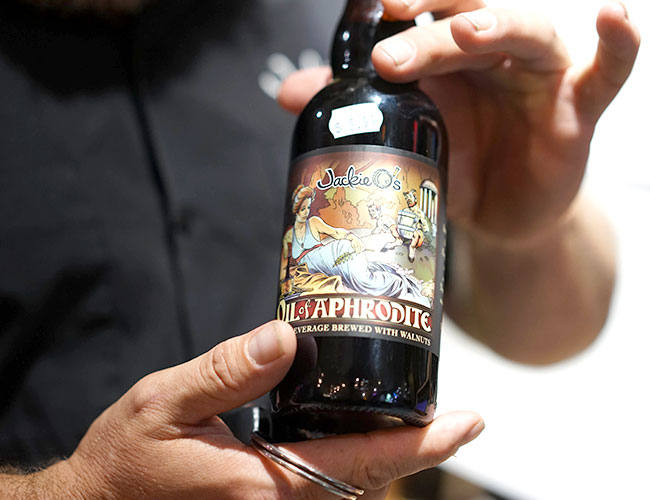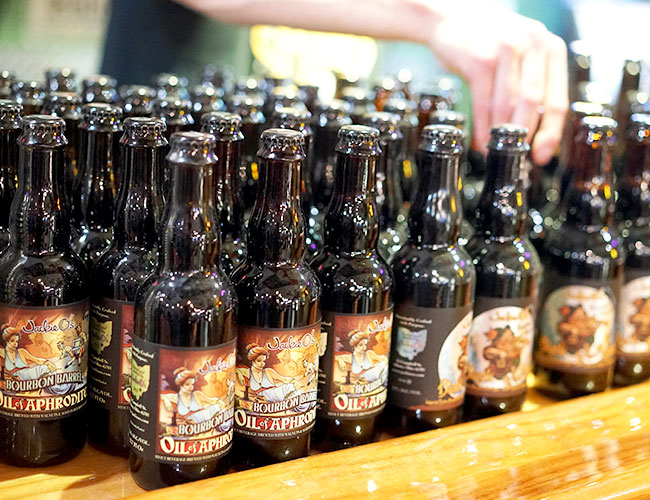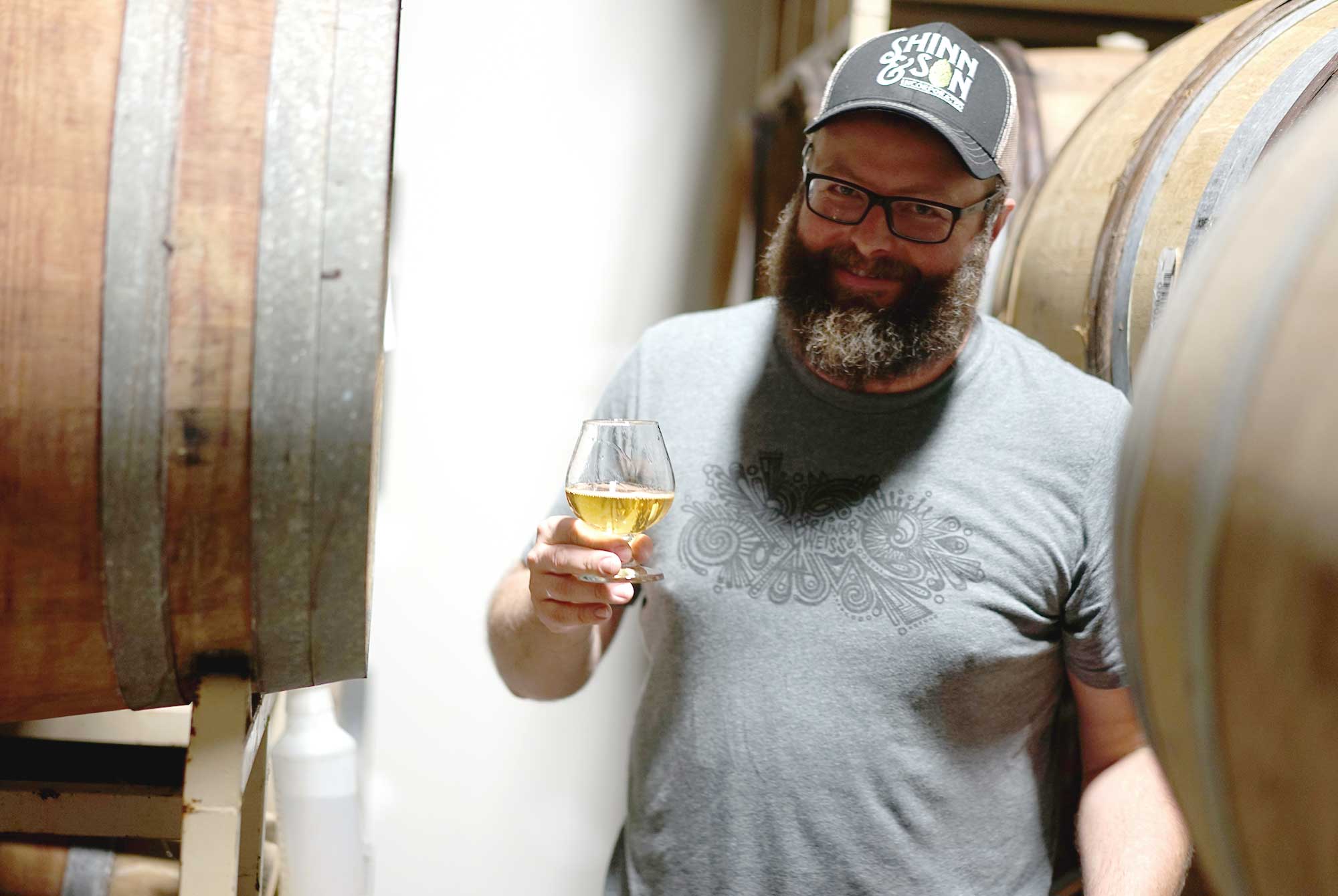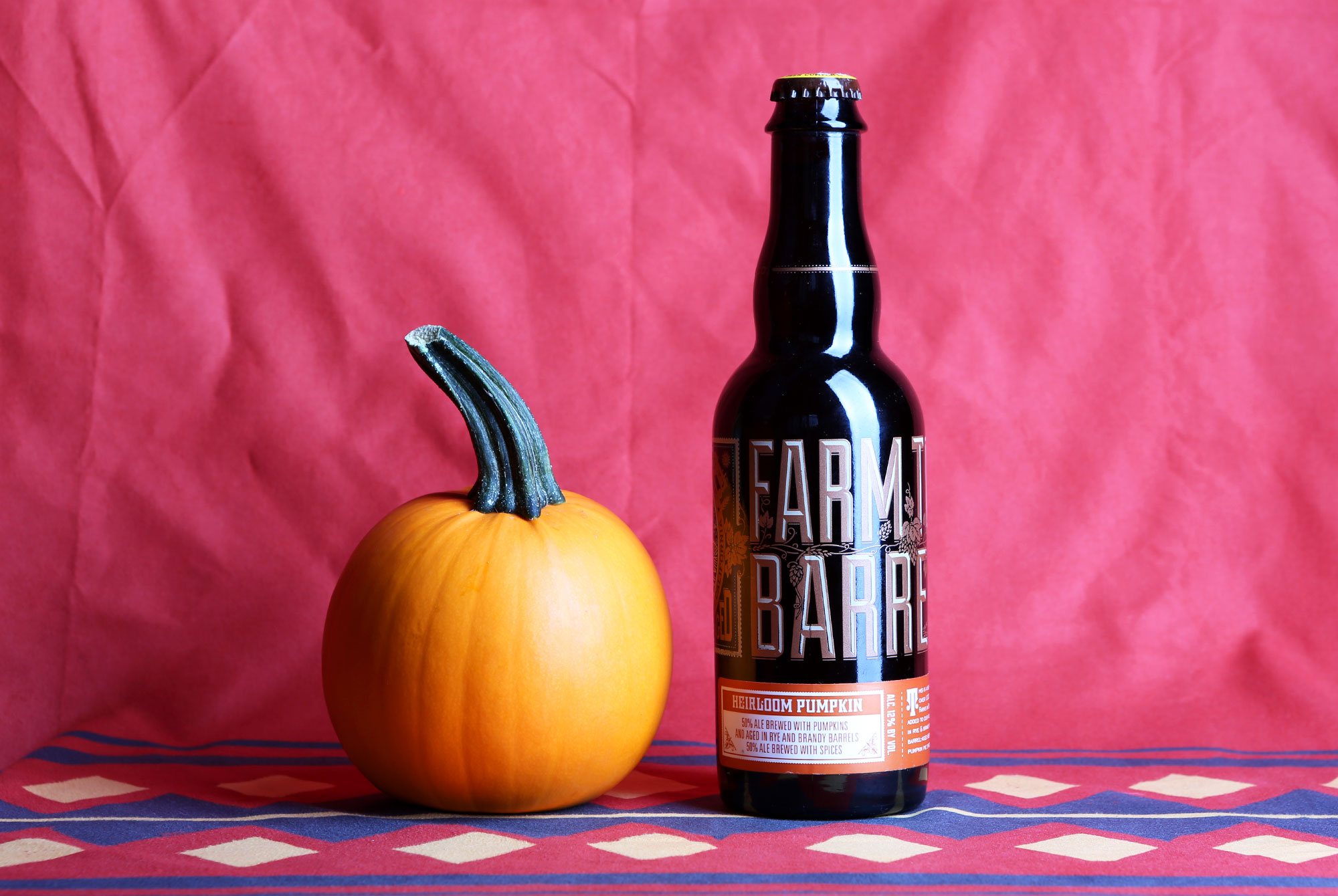Shop
An Interview with Ohio’s King of Barrel-Aging
In the words of Jackie O's co-founder Brad Clark, everyone at the brewery wants to brew beer with their friends and die.
Until Brad Clark made his first professional batch of beer on a seven-barrel system, he’d only ever brewed using extract malt. It’s the equivalent of playing Operation and then moving to heart surgery. Getting a poem put on the fridge, and then publishing a book. But Clark rose to the occasion. Twelve years later, he’s the co-founder of Jackie O’s Pub and Brewery in Athens, Ohio, one of the greatest producers of barrel-aged stouts and sours in the country.
If Clark’s path seems strange, consider the fact that he’s had over a decade to perfect his craft. In comparison to the newest generation of hip brewers, who founded their breweries only two or three years ago, he’s an old hat. He also holds brewing degree from the esteemed Siebel Institute in Chicago, Illinois. But perhaps most importantly, he has a team that loves beer — in his words, the team “wants to make beer and die together.”
We met Clark at his Athens, Ohio brewpub to talk about barrel-aging, collaborations, and the difference between American and English-style Barleywines.
Kenny Gould: How did you get into beer?
Brad Clark: I was going to school here in Athens at Ohio University, and I got into homebrewing because I was drinking at a local bar and brewery called O’Hooley’s. I actually started working there when I was 21, and the guy who was brewing there had opened up a homebrew shop. I’d already been buying magazines and getting into the scene but I finally started homebrewing myself.
KG: And then you met your co-founder, Art?
BC: Art and I were friends and I started to share my homebrew with him. I knew that he was interested in getting into the bar business. At that point, O’Hooley’s was going under. There hadn’t been any beer brewed there in about a year. I said, “You should look into O’Hooley’s.” Six months later, he got it. He said, “If you want to stick around after you graduate, you can be the brewer.”
KG: But at that point, you didn’t have that much experience.
BC: At that point, I only had about a year of extract homebrewing under my belt. But I said, “Okay.” I graduated in June of 2006, and two days later I brewed my first all-grain batch on the seven barrel brewpub system.
KG: Was your first beer any good?
BC: Uh, it’s hard to say. But those beers sold. We had some hiccups and learned a lot. We’ve had infection issues. There’s always things to learn and improve upon.
KG: At some point, you switched the name from O’Hooley’s to Jackie O’s?
BC: We’d gotten brewing back up and we were serving food which hadn’t been done in a long time. The place was clean. It was time to put a new name on it. We named it Jackie O’s to pay homage to the Irish heritage of the bar and the original brewpub. It was also named for Jackie Oestrike, which is Art Oestrike’s — the other owner’s — mother. She passed away about six months after Art had gotten the brewpub. So the name had kind of a dual meaning. Over the years, we’ve shed most of the Irish connection, and the name has become more about maternity, family, and community.


KG: I still think it’s crazy that you brewed on seven barrel system without experience. How did you know how to do that?
BC: I got some training from previous brewers at O’Hooleys, and then I had almost a year to figure things out on my own. Then in 2007, I went to the Siebel Brewing Institute in Chicago. After I came back, I started making Imperial beers and experimenting with barrel-aging, because I understood the process and ingredients a lot better. From there, things kept growing. The brewpub bought the space next door and expanded the restaurant, which allowed us to expand the brewing capacity. In 2010, we bought a farm, and in 2011, a new production facility. Throughout that time, we’ve just continued to improve, expand, and grow.
KG: How many employees did you have when you started? And how many do you have now?
BC: When we started, we had six employees — we now have a little over 140. We are a large employer and an impactful business within the Athens community. We’re coming up on 12 years in December.
KG: Wow. That’s a lot of growth.
BC: From 2006 to 2009, we only had two fermentors at the brewpub. We could only brew about six times per month. In 2009, we got the restaurant next door, and we were able to expand our fermentation capacity. We added three more fermentors. We went from doing 300 barrels per year to 800. In 2012 and 2013, we went from 800 to 3,200 because we got the new production facility.
People have been responding.
BC: We’ve had pretty steady 20 to 40 percent growth years over the past four and a half years. It’s been steady and big, but it’s also been well-thought out and planned. Next year, we’re shooting for 20 percent growth, which would get us to fifteen, maybe fifteen and a half thousand barrels. Which is great, but not a lot compared to some other breweries.
KG: Well, no. But are you trying to be a big regional brewery?
BC: We’re going for the New Glarus model. We do send beer to other states: California, Colorado, Florida, Virginia, and sometimes Vermont. We’ve sent beer to Denmark, which then hits the whole EU. But mostly that’s bottles from our specialty programs, because they’ve grown a little too large for the state of Ohio. But 99 percent of what we make gets sold in Ohio.
A lot of what makes our decisions is that we really want to enjoy our jobs, and make sure that everyone we work with also enjoy theirs. We also want to make sure we can continue enjoying for a long time. So we don’t need to break into other states. We’re not trying to grow fast or grow to be something enormous. We want to be sustainable with our practices and growth. We joke about it, but we all want to make beer and die together. It’s not about how many thousands of barrels we make per year, it’s about, “Is the business healthy? Are we taking care of our employees? Is this working from a holistic viewpoint, rather than numbers and ROI?”
KG: Does that ethos come from the top down?
BC: Yeah. It’s like, beer first, profit later. And it’s always been that way. Our business has to be seated on something, and that’s the product. Everything stems from there.
KG: When I think of Jackie O’s, I think of barrel-aged stouts and sours.
BC: Stouts were our jump-off point. That’s what we got known for — Dark Apparition. We expanded off off that and created Oil of Aphrodite. I’ve always had a knack for darker, more malt-forward beer. It took a long time for us to get our IPA game to where it is now, which could even be better. We’re still working on IPAs a little bit, but it’s hard with what’s going on with IPAs right now.
KG: Speaking of that… Jackie O’s also makes IPAs.
BC: IPAs are about 50 to 60 percent of what we produce out of our brewery. Out of our thirteen and a half thousand barrels we make in a year, seven to eight thousand of that are IPA. Mystic Mama is what we believe to be a good IPA, especially when it’s fresh—it’s kind of bitter, it’s old school, it’s clear. Seven percent. It’s modeled after Racer 5 and Alpine Duet, some of the older beers that were coming out of California in 2007 and 2008.
KG: So what do you think about the battle between the new and the old school IPA?
BC: There’s a lot happening right now. It’s well known that I’m not a proponent of hazy IPAs or kettle sours. I don’t drink a lot of them. The lack of bitterness always confuses me. Needless to say, the companies that are doing them—and doing them well—are doing great from a business standpoint. They’re extremely popular. You look at top 100 lists and it’s amazing how many of them are Pale Ales or IPAs. I believe that some people are pushing it too far, and that there’s a dilution of style within the IPA sector. It could be argued that somebody who started drinking craft in late 2016 couldn’t give you an accurate description of what IPA is, or what that style means. But we’re sticking to our guns. We make old school, clear IPAs. You get that citrus, pine, dank character, but not the fruit bomb.
KG: Would you make a fruit bomb?
BC: We are looking at those flavor profiles and trying to find a happy medium, maybe something that has some of that sweetness and a fruity component but is still clear and clean. There’s not a lot of that in the market, which I think is bizarre. When I was doing hop selection just this past week, I was getting some Columbus hops. There was one lot that smelled a lot like Columbus should, but there was another one that was fruitier than Columbus should be. But I selected the second one. That flavor profile is where the market is shifting. I think it’s important not to be set in your ways and to be willing to make slight adjustments. Palates are changing. The market is changing. Shelf space and tap handles are harder to get in maintain. Saturation is real. You have to be willing to move within the craft beer sector.
KG: Do you enjoy that part of the business?
BC: It’s fun. It pushes you to brew things you wouldn’t normally brew. Sometimes you need to take things to a level that’s uncomfortable, a level that’s too far, just so you know where it is. Then you back it off and find the medium. There’s a lot of effort and time and money that goes into it. Maybe it’s received well, or maybe poorly, but either way, it’s exciting.
KG: What’s that beer in the fridge?
BC: That’s Elaborative 4, an old beer that we brewed with Hill Farmstead. They never released it because it was overcarbonated. Sean Hill sent me cases of that shit. It was a collaboration between Side Project, Crooked Stave, Jackie O’s, and Hill Farmstead.
KG: Who have been some of your favorite people to collaborate with?
I don’t know. I always have a fun time working with Side Project. I used to do a ton with Hill Farmstead — we haven’t done one in a while, but Sean and I have known each other for a while and been collaborating since 2011. Tired Hands is always a good time. We’ve done a number of collabs with Sante Adairius — they’re great to collaborate with, and Adair, one of the owners, is my fiancé, so I have a particular affinity toward them. We had a great time brewing with Cycle, Creature Comforts, Tool. Evil Twin. Jeppe was just here. We have Burial coming at the end of the month, Jester King coming at the end of January, and next year we have a bunch. Oh, and Cellarmaker was fun! There’s so many great people in this industry.
KG: What is this beer we’re drinking?
BC: This is an American-style Barleywine that’s been in a barrel for about a year. Normally, I just do English-style, but we pushed this a little bit. The difference is the hoppiness and color. This one has picked up a lot of color from the char in the barrel and also oxidation; my regular barleywines are almost black, like quad-colored.
KG: Does this one have a name?
BC: We call it Patriarch. We make a triple IPA called Matriarch, so it just kinda made sense. Taste it — it’s like marmalade and vanilla. It’s getting there. I don’t have a set release date because we put a lot of stuff in the barrel just to see what happens. Either it’ll be good on its own or I’ll use it as a blending tool.
KG: Where do the names for the beer come from?
BC: They’re all inspired by different things. Brick Kiln, Scrip, and Iron Furnace are nods to local industry. My degree from Ohio University is in creative writing, so that comes in handy when naming things. I do all the writing for the company. Honestly, there’s not a real rhyme or reason to the names, but they’re all from the heart. There’s nothing fictitious about them, no made up backstories. For the most part, everything has a real story. In this day and age, I think that’s really important, and that’s what the consumer will always be attracted to. Everybody likes a good story. They want to feel attached to a brand or product, and the easiest way is to give them the backstory. If it’s interesting and unique, all the better. After twelve years naming hundreds of products, it’s still one of my favorite parts of the business. I do a lot of travel, and I’m always writing things down in my phone. Names, flavor combinations, that sort of thing. I’m about to do a line of fruited beers named after fabric patterns: Houndstooth, Herringbone. Then all of the sudden, I’m researching fabric patterns. But it’s fun to see where things go. A lot of these beers don’t have a name when they’re first made; that comes later, once we figure out the personality of the beer. I just try to stay open and receptive to what’s going on around me.
KG: Do you have a favorite name?
BC: Dark Apparition was a beer that I put a lot of thought and time into. It was an early beer for me to create. When it came down to the naming, Dark Lord was popular, and Surly had just come out with Darkness. I was working with that, and in Athens we have a whole haunted culture. After Madison, Wisconsin, we actually have the second-largest Halloween celebration int the US. I wanted to play off that naming convention and the history of Athens, so I came up with Dark Apparition.
KG: That was your first barrel-aged beer, no?
BC: Bourbon Barrel Aged Dark Apparition in 2008. Draft only.
KG: Was there a line for that?
BC: No way. It was growler fills, and it was 2008.
KG: I’m just thinking of your recent Appervation release, which had a huge line…
BC: We still don’t have lines for the majority of stuff we release. Appervation was different because it was a collaboration with Side Project. Corey and I did that, and that’s what made that one different. But we release two, sometimes three barrel aged beers per month, and we release hundreds of cases of them. So it doesn’t always mean lines. It goes into distribution and people can get it on the shelves. That’s good and bad. We don’t have a lot of on-site, over-the-counter sales, but in general we have a consumer base that’s pleased we’re making a lot of it, and that it’s easy to obtain. It’s not a chore to wait in line or get a hotel room. You don’t have to come to Athens. However, we are looking to do some more specialty stuff that brings people into the taproom, but that’s for 2018.
KG: More collaborations?
BC: We have a lot. I do almost one or two per month. But we’re also doing smaller, taproom-only blends, and we have a bunch of double barrel projects going on right now. As you can see, I have a lot of stuff to work with.



